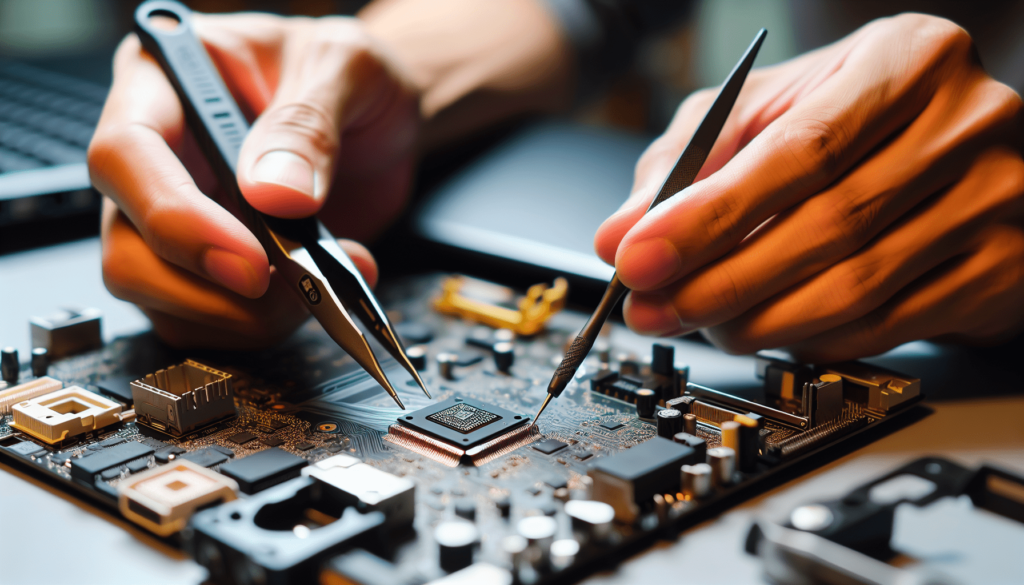Have you ever encountered a problem with your laptop’s BIOS chip and wondered if there’s a cheaper way to fix it? Many people have faced this issue, and it can seem daunting and expensive. The good news is that there might be more affordable alternatives to consider.

Understanding the BIOS Chip
What is the BIOS Chip?
The BIOS (Basic Input/Output System) chip is crucial for booting your laptop. It contains the code needed to initialize and manage hardware resources. Think of it as a little behind-the-scenes guide that tells your laptop what to do before it even thinks about loading Windows or macOS.
Why is the BIOS Chip Important?
Without a functioning BIOS chip, your laptop simply won’t start. It’s like trying to start a car without a key; everything else might be in perfect working condition, but you simply can’t get things running. The BIOS chip initiates the startup sequence, recognizes hardware components, and prepares the system for the operating system to take over.
When the BIOS Chip Fails
Signs of BIOS Chip Failure
Recognizing the symptoms of a failing BIOS chip can save you troubleshooting time and frustration. Here are common signs:
- No POST (Power-On Self Test): When you press the power button, nothing happens. The screen stays black, and you might not even hear any beeps.
- Error Messages: Your laptop might display a BIOS-related error message or beep code, indicating a problem during the startup sequence.
- Skipping BIOS Setup: If the laptop skips the BIOS setup menu or takes an unusually long time to boot, the chip might be faulty.
Common Causes of BIOS Chip Issues
Several factors can lead to BIOS chip problems:
- Power Surges: An unexpected surge in electricity can damage the chip.
- Corrupted BIOS: Incorrect BIOS updates or malware can corrupt the chip.
- Physical Damage: Physical damage to the motherboard can affect the BIOS chip.
Traditional Fix: Replacing the BIOS Chip
Cost of Replacing the BIOS Chip
Replacing the BIOS chip traditionally can burn a hole in your pocket. Here’s why:
- Service Costs: Professional repair services charge for labor, sometimes more than what the chip itself costs.
- Component Prices: Depending on your laptop model, the BIOS chip can range from $20 to over $100.
- Shipping: If the repair involves shipping your laptop to a service center, that’s an additional expense.
Here’s a rough cost breakdown:
| Expense | Cost Range |
|---|---|
| Service Fee | $50 – $150 |
| BIOS Chip | $20 – $100+ |
| Shipping | $10 – $50 |
| Total Estimate | $80 – $300+ |
Warranty and Repair Considerations
Before you go down the replacement route, check your warranty status. Some manufacturers offer free repairs if the laptop is under warranty. If it’s not, you’re looking at the out-of-pocket costs outlined above.
DIY Solutions for Fixing the BIOS Chip
Flashing the BIOS
Flashing the BIOS is like giving your laptop’s firmware a fresh coat of paint. It can resolve issues without costing a dime, provided you have a USB drive and a bit of patience.
Steps to Flash the BIOS:
- Download BIOS Update: Go to your laptop manufacturer’s website and download the latest BIOS update file.
- Create a Bootable USB Drive: Use a tool like Rufus to create a bootable USB drive with the BIOS update file.
- Enter BIOS Utility: Insert the USB drive into your laptop, restart it, and enter the BIOS setup utility.
- Run the Update: Follow the on-screen instructions to flash the BIOS using the file on your USB drive.
- Reboot: Restart your laptop after the update completes.
Hot Flashing
Hot flashing involves using another computer to reprogram your faulty BIOS chip. It’s a bit riskier but can be a lifesaver.
Required Tools:
- DIP extractor
- Another working motherboard with a compatible BIOS chip
Steps to Hot Flash:
- Prepare the Working System: Turn off the working computer and remove its BIOS chip using the DIP extractor.
- Insert Bad BIOS Chip: Carefully insert the faulty BIOS chip into the working system.
- Flash the BIOS: Boot the working system and run the BIOS flash utility to reprogram the faulty chip.
- Reinsert the Chips: Turn off the system, reinsert the original BIOS chip, and put the freshly flashed BIOS chip back into your laptop.
Reprogramming with a SPI Programmer
An SPI programmer is a device that can write data directly to the BIOS chip. This method requires some technical know-how but offers a permanent fix without needing a full replacement.
Required Tools:
- SPI programmer (e.g., CH341A)
- SOIC8 test clip
Steps to Reprogram:
- Connect the Test Clip: Attach the SOIC8 test clip to the BIOS chip on the motherboard.
- Connect to the Programmer: Link the test clip to the SPI programmer and connect it to your computer.
- Download BIOS File: Obtain the correct BIOS file from your laptop’s manufacturer.
- Use Programmer Software: Open the programming software (often provided with the SPI programmer) and load the BIOS file.
- Flash the Chip: Follow the software’s instructions to write the new BIOS file to your chip.

Budget-Friendly Alternatives
Repair Cafés and Maker Spaces
Repair cafés and maker spaces are fantastic community-driven initiatives where people help each other fix their gadgets. These places are filled with tools, knowledgeable volunteers, and like-minded DIY enthusiasts. You can find help without spending much, and sometimes for free.
Online Communities
Several online communities and forums can walk you through the fixing process. They offer step-by-step guides, troubleshooting tips, and moral support.
Popular forums include:
- Reddit’s /r/hardware: A great place for troubleshooting advice and solutions.
- Tom’s Hardware: Known for detailed guides and a helpful community.
- DIY Repair Subreddits: For more niche advice, these can be more specialized and focused on DIY fixes.
Local Computer Repair Classes
Sometimes, investing in learning a new skill is worth it. Check out local community colleges or adult education centers for affordable computer repair classes. These classes provide hands-on experience in fixing various computer issues, including BIOS-related problems.
Preventative Measures
Regular Updates
Keeping your BIOS updated is essential for the smooth operation of your laptop. Manufacturers release updates to fix bugs, enhance performance, and improve compatibility. Make it a habit to check for updates periodically on your manufacturer’s website.
Surge Protectors
Electrical surges can instantly damage delicate components like the BIOS chip. Using a surge protector for your laptop can save you from potential damage caused by unexpected power surges.
Backup Power Solutions
Uninterruptible Power Supplies (UPS) can provide backup power during outages, allowing you to safely shut down your laptop and save your BIOS from corruption caused by sudden power loss.
Proper Handling and Maintenance
Treat your laptop with care to avoid physical damage. Ensure it is kept in a safe, dry place, away from potential physical hazards. Regular cleaning of the laptop vents ensures proper airflow, which helps in maintaining optimal operating conditions and prolonging the lifespan of internal components, including the BIOS chip.
When All Else Fails: Replacement
Choosing the Right Service Provider
If you’ve tried the DIY methods and are still stuck, it might be time to replace the BIOS chip professionally. Here’s how to choose the right service provider:
- Reputation: Look for providers with good reviews and ratings.
- Warranty: A good provider should offer some guarantee on their work.
- Cost: Get quotes from multiple providers and compare prices.
Professional Replacement Procedure
Understanding the procedure can give you peace of mind when you hand over your laptop for repair.
Steps Followed By Professionals:
- Diagnosis: Confirm the BIOS chip is the culprit.
- Extraction: Safely remove the faulty chip.
- Programming: Program the new or reprogrammed chip with the correct BIOS firmware.
- Installation: Install the new chip and test the laptop thoroughly.
Expected Costs and Turnaround Time
The costs can vary based on the complexity and the specific model of your laptop. Here’s an estimate of potential expenses and turnaround:
| Expense | Cost Range |
|---|---|
| Professional Service Fee | $100 – $250 |
| New BIOS Chip | $20 – $100 |
| Total Estimated | $120 – $350 |
Turnaround times can vary from a couple of days to a week, depending on the service provider’s workload and part availability.
Weighing Your Options
Pros and Cons of DIY Repairs
DIY repairs can be rewarding but are not without risks. Here are some pros and cons to help you decide:
| Aspect | Pros | Cons |
|---|---|---|
| Cost | Can be much cheaper than professional repairs | Potential for costly mistakes |
| Learning | Gain valuable technical skills | Time-consuming |
| Control | Full control over the repair process | Risk of further damage if not done correctly |
Comparing Costs
Evaluating different options based on cost, effort, and skill level required can help in making an informed decision.
| Repair Option | Estimated Cost | Skill Level | Effort |
|---|---|---|---|
| Professional Replacement | $120 – $350 | Low | Low |
| Flashing the BIOS | Free | Medium | Medium |
| Hot Flashing | Minimal | High | High |
| SPI Programmer | $10 – $20 | High | High |
Making the Decision
Assessing Your Technical Skills
Do you enjoy tinkering with gadgets, or does the thought of opening your laptop send shivers down your spine? Be honest about your technical skills before choosing a DIY method.
Evaluating Your Financial Situation
Sometimes, the decision boils down to finances. If you’re tight on funds, a DIY fix might be the way to go. However, if you can afford it, professional repair offers peace of mind.
Considering the Importance of Your Laptop
How vital is your laptop to your daily life? If you rely on it for work or school, getting it fixed quickly and reliably might be more important than saving a few bucks.
Conclusion
Fixing your laptop’s BIOS chip doesn’t always have to be an expensive or daunting task. By understanding the different options available—ranging from DIY fixes like flashing the BIOS to seeking professional help—you can choose the method that best suits your needs, budget, and skill level. Remember, taking preventative measures can also save you from future headaches, ensuring your laptop runs smoothly for years to come. Whatever route you decide, know that a bit of knowledge and effort can go a long way in bringing your laptop back to life without burning a hole in your pocket.

